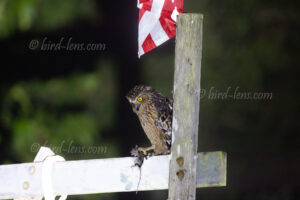 After successful daytime birding, we go on the night drive around 8 p.m. The boat trip will be undertaken with a total of 3 employees from the lodge – including Nelson. One holds the lamp, one drives, and Nelson adds his two cents. The hit of the evening should be of course the Buffy Fish-Owl (Ketupa ketupu). At first, the Buffy Fish-Owls (2 individuals) just sit still – facing away – on power poles. But then we see a Buffy Fish-Owl on a jetty post, which even has a rat in its catch. This Buffy Fish Owl even shows its half-eaten rat deliberately and is standing not that far away. The distance is only 30 meters.
After successful daytime birding, we go on the night drive around 8 p.m. The boat trip will be undertaken with a total of 3 employees from the lodge – including Nelson. One holds the lamp, one drives, and Nelson adds his two cents. The hit of the evening should be of course the Buffy Fish-Owl (Ketupa ketupu). At first, the Buffy Fish-Owls (2 individuals) just sit still – facing away – on power poles. But then we see a Buffy Fish-Owl on a jetty post, which even has a rat in its catch. This Buffy Fish Owl even shows its half-eaten rat deliberately and is standing not that far away. The distance is only 30 meters.
Cruising along the Kinabatangan river at night has always been very interesting and also a different kind of experience one can get from it. Night time always brings out things that cannot be seen during the day. And so we came across this Buffy Fish-Owl and his half eaten dinner of a rat. He was not too perturbed by our close presence.
The Buffy Fish-Owl, as the name implies, feeds mainly on fish. However, this species of owl also feeds on frogs, reptiles, crustaceans, large aquatic insects and small mammals and birds. And small mammals include rats and mice. Buffy Fish-Owls forage at night by the water edge or in shallow water.
In the dark, low light, only illuminated by the bright spotlights of the tour leader, I shot at 1/30-1/124 sec and auto ISO. My Canon R 5 had no trouble focusing in these circumstances, although the contrast was highly depending on the availability and stability of the torch light. I am not sure, wether it would have been useful to manage the images with flash because of the distance.
In total we see 3 Buffy Fish-Owls. We then explore the banks with the leaders thermal imaging camera. One or two White-breasted Waterhen (Amaurornis phoenicurus) can be seen. Of course, a few monkeys are still up to mischief. One or two Tree Rats can also be detected. Otherwise, only 2 Striated Heron (Butorides striatus), two beautifully side-on-side sitting Black-and-red Broadbill (Cymbirhynchus macrorhynchos) and a total of 3 Blue-eared Kingfisher (Alcedo meninting), which now sit completely still at night, can be seen and can also be photographed very well
In order to meet the growing demand for top images of the rarer species of Palaearctic Bird-lens.com has specifically made trips to remote places. Additionally every chance is used, if a rare bird is around the homeground. This to do everything to ensure excellent photos of the Birds of the Western Palearctic . The yield of pictures also of rare Western Palaearctic birds is very good. There are other nice images of birds, that you will find behind the tab “Picture Shop“. Just give a notice if you need a picture of a bird which is not online.